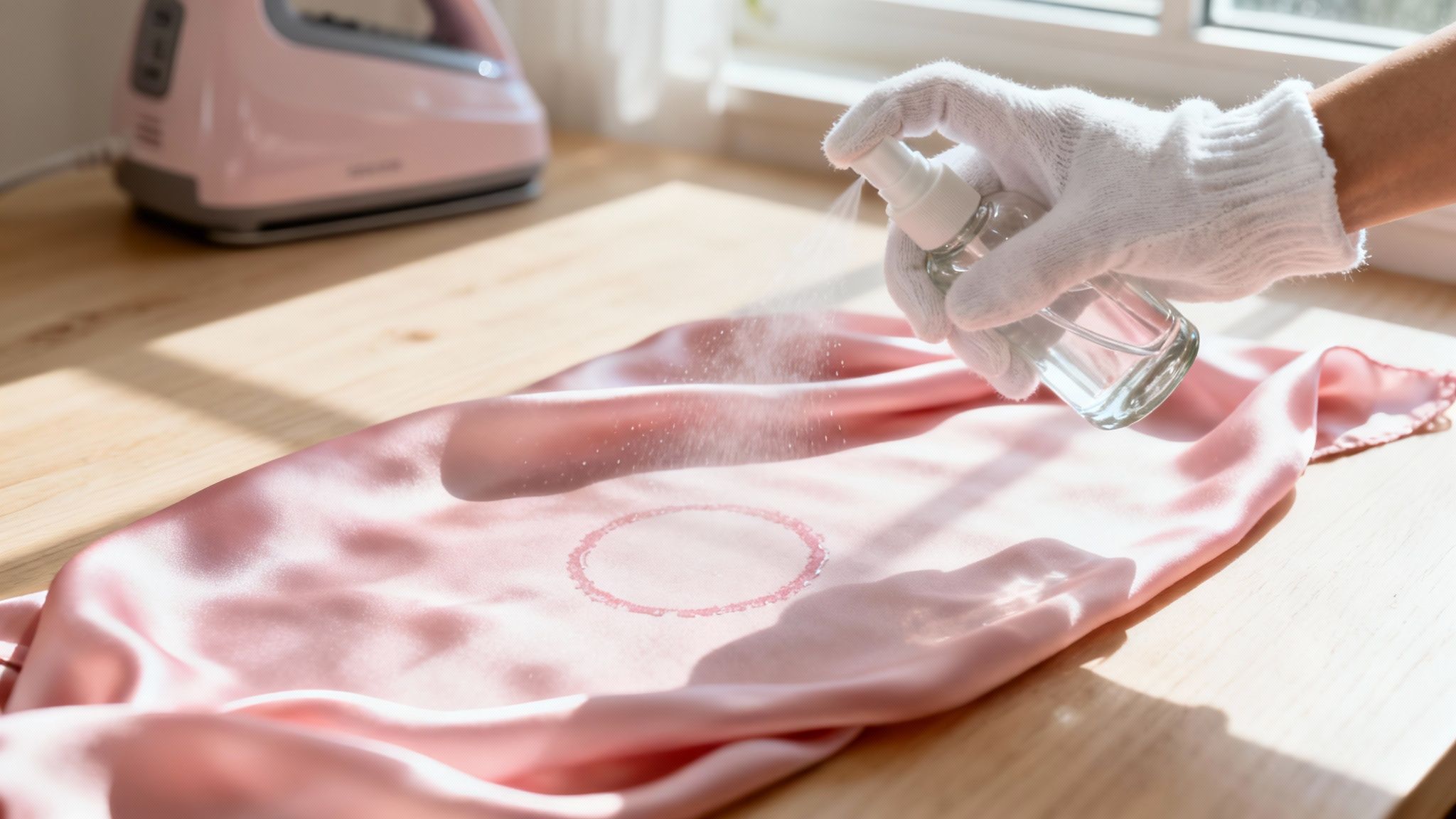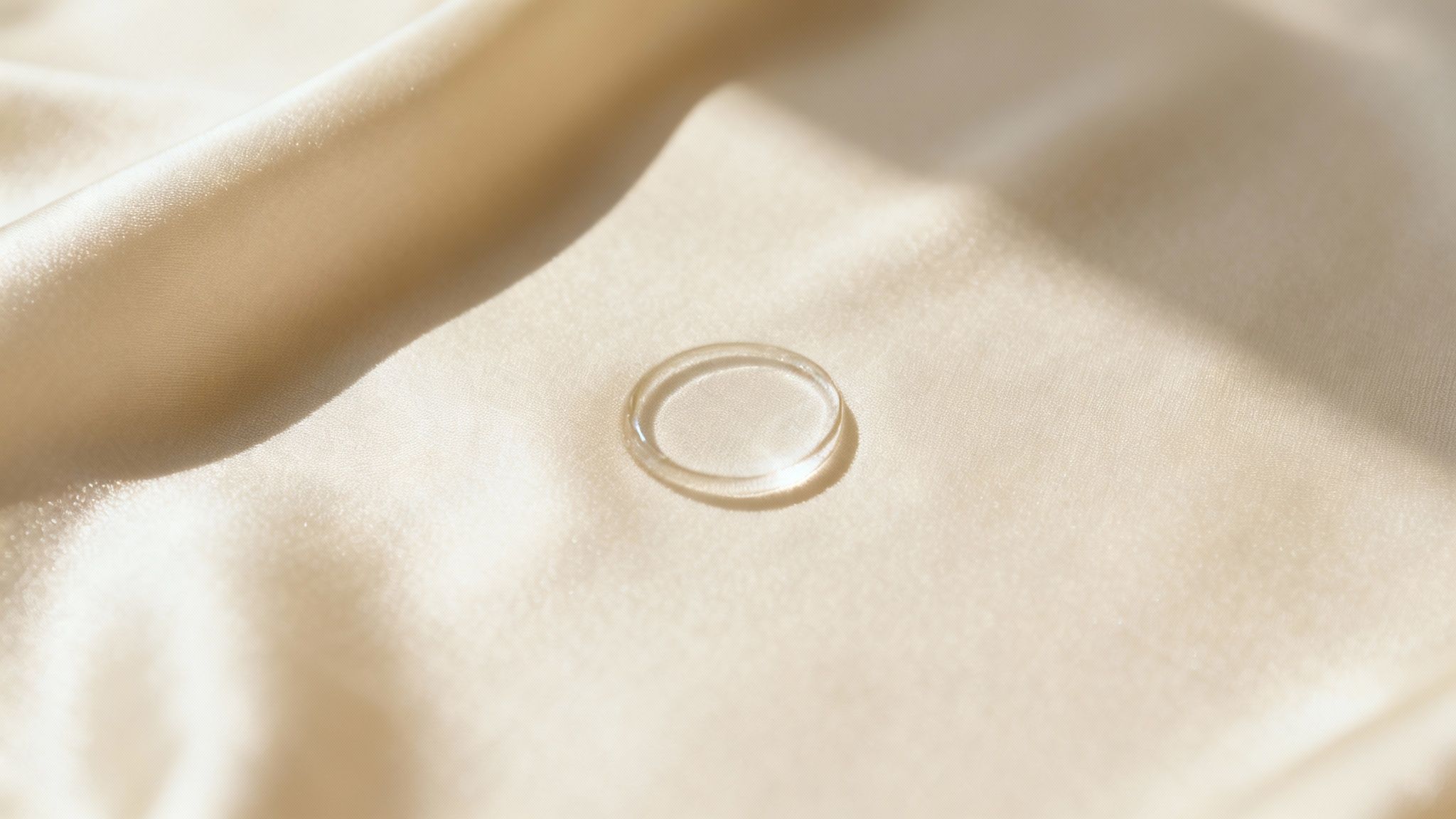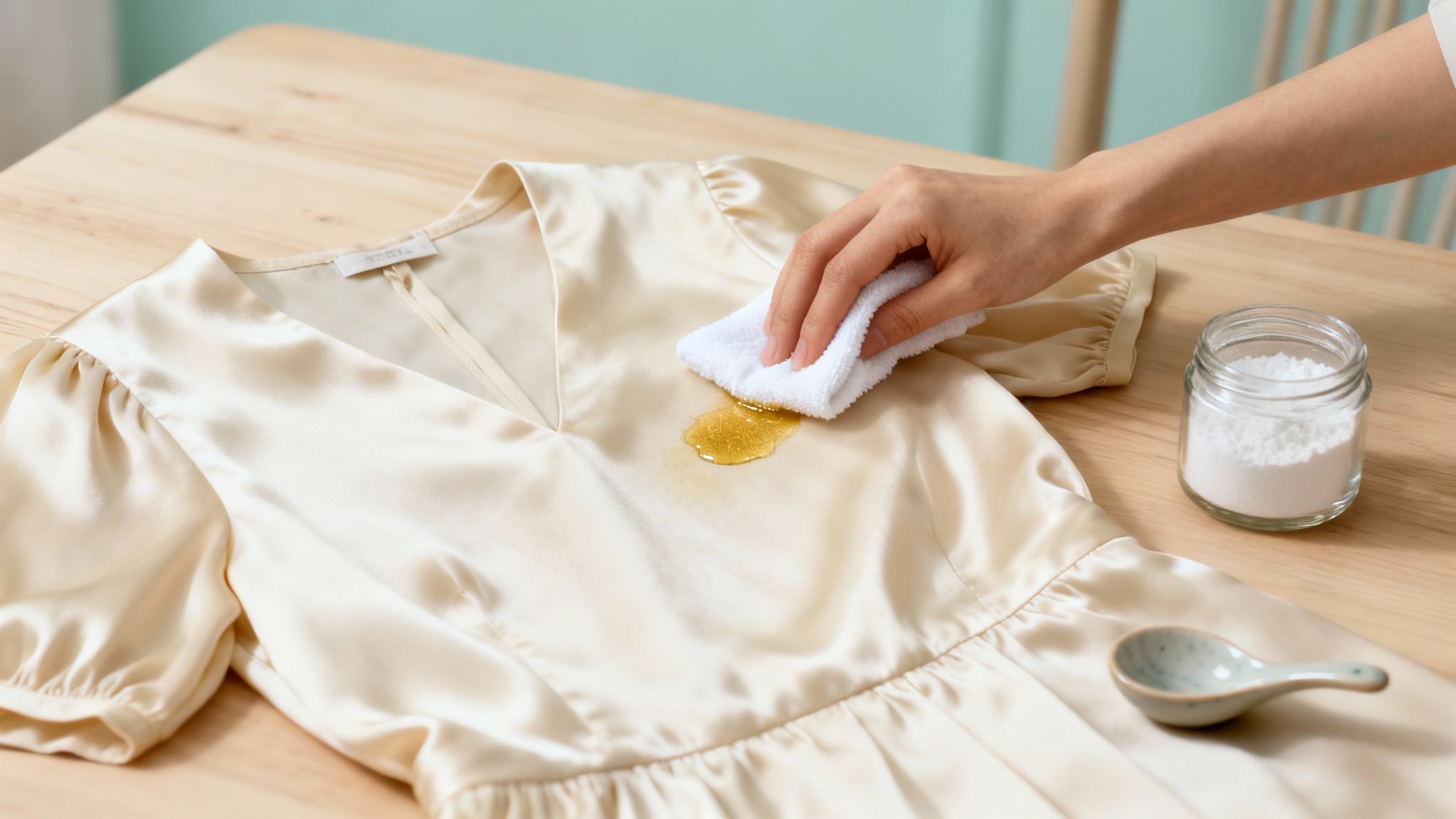How to Remove Water Marks on Silk at Home

It’s a scenario every silk owner dreads: a single drop of water splashes onto your favorite blouse, and as it dries, a distinct, darker ring forms. You might think you've permanently stained it, but what’s actually happening is more of a physical reaction within the fabric, not a chemical one.
Getting a handle on this process is the first step to fixing it without accidentally making things worse.
Why Water Leaves Marks on Silk Fabric
Water marks on silk aren't true stains. They're more like optical illusions—disruptions in the fabric's delicate fibers caused by moisture. When a drop of water hits silk, it displaces the protein fibers, changing how they catch the light and creating that frustratingly noticeable ring. The problem often gets a boost from minerals in tap water, which stick around long after the water itself has evaporated.

Silk is a natural protein fiber, mostly made of something called fibroin. Its fibers have a smooth, prism-like structure, which is what gives the material its signature luster. Unfortunately, this very structure is also what makes it so vulnerable to water marks.
The Role of Fiber Disruption
When moisture soaks into the fabric, it makes the delicate silk fibers swell up and shift around. As the water dries, the fibers don't always settle back into their original, perfectly uniform position. Instead, they can get a little roughened or pushed out of place, especially right at the edge of the damp spot.
This subtle change is enough to alter how light reflects off the fabric's surface. The area inside the ring might look perfectly fine, but the perimeter—where the water stopped spreading—catches the light differently. That’s what creates the visible outline we call a water mark on silk.
Think of it like this: Imagine a perfectly combed carpet. If you spill a little water on it, the wet fibers get pushed around. Once dry, they might not lie as flat or in the same direction as the rest of the carpet, creating a noticeable spot even though nothing was actually added or taken away.
The Problem with Minerals
The issue often gets worse depending on the type of water. Most of our tap water contains dissolved minerals like calcium and magnesium. When a drop of this "hard water" dries on your silk garment, the water evaporates, but those mineral deposits get left behind.
These tiny mineral crystals can basically encrust the silk fibers, making them stiff and further messing with the fabric's smooth finish. This is why a mark from tap water is often much more obvious—and harder to remove—than one from distilled water, which is completely mineral-free. You're not just dealing with displaced fibers, but also a faint, chalky residue that makes the visual effect even stronger.
Your Essential Pre-Treatment Safety Check
Before you even think about tackling a water mark on silk, pause. Taking just a few moments for a quick safety check is hands down the most important thing you can do. This brief pause can be the difference between fixing a small spot and creating a permanent disaster. Trust me, rushing this step is a risk you don't want to take.

This isn't just about how the fabric looks; it's about protecting the silk itself. Research into silk degradation shows that water doesn't just leave a mark—it can actually speed up the breakdown of the delicate protein fibers. In some studies, prolonged humidity caused a 40% reduction in the fabric's strength. That water spot might be a sign of deeper, molecular damage.
First, Decode the Care Label
Think of your garment’s care label as its instruction manual. Ignoring it is the quickest way to ruin your favorite silk piece. Those little tags hold all the secrets to what you can and can't do.
- A Circle Symbol: See a circle? That means "Dry Clean Only." Stop right there. Any at-home water treatments are a no-go and could lead to shrinking, bleeding color, or a weird texture.
- A Basin with a Hand: This little icon is your green light! It means the item can be hand-washed, so gentle, at-home water remedies are on the table.
- Anything with an "X": An "X" through any symbol is a hard "no." A crossed-out iron, for instance, is a clear warning that heat will wreck the fabric.
Understanding these symbols is key. For example, while it might be tempting to grab a common stain remover from under the sink, it's vital to know what chemicals are safe. Our guide on whether hydrogen peroxide stains clothes can give you more insight into how different products react with delicate fabrics.
The Non-Negotiable Spot Test
Okay, so the care label says you can hand-wash. You're still not ready to go. You absolutely must do a spot test first. Dyes in silk, especially in those gorgeous, deeply colored pieces, can be surprisingly unstable. A spot test is your final confirmation that your cleaning method won't make the color bleed or fade away.
Pro Tip: Always test on a hidden area. Think of an inside seam, the hem allowance, or maybe behind the collar. If anything goes wrong, no one will ever see it.
Here’s how to do it: dab a tiny bit of your cleaning solution (even if it's just distilled water) onto that hidden spot with a cotton swab. Let it sit for a minute or two, then gently blot it with a clean white cloth. Look at the cloth—see any color? Let the spot air dry completely and check for any changes in color, texture, or sheen. If it looks exactly the same, you’re good to go.
Tried-and-True Ways to Remove Water Marks at Home
Once you've done your due diligence with the safety checks, you're ready to take on that pesky water mark. Here are three reliable methods you can try right at home. I’ve ordered them from the gentlest to the most assertive—always, always start with the mildest option first to keep your silk safe.

Method 1: Even Dampening and Blotting
This is your safest first bet and often the most effective trick, especially for fresh water marks. The idea is simple: you want to blend the edges of the water ring into a larger, uniformly damp area so the whole section dries evenly, without a trace.
Start by laying your silk item flat on a clean, white towel. Grab a spray bottle filled with distilled water and lightly mist the entire panel of fabric where the stain is, going from seam to seam. The key is to avoid soaking it; you're just aiming for an even, light dampness across the whole area.
Now, place another clean, white towel on top and gently press down. This blotting motion wicks away the excess moisture without rubbing or stressing the delicate fibers. Whatever you do, don't twist or wring the silk! Let it air dry completely, either flat or on a padded hanger away from any direct heat or sunlight.
Method 2: Using Steam to Relax the Fibers
If the mark is a little more stubborn, steam can be a game-changer. The combination of gentle heat and moisture helps the silk fibers relax and settle back into their original weave, which can make that water ring vanish.
A handheld garment steamer is the perfect tool for this job. Hold it a few inches away from the fabric and keep it moving continuously over the spot. Constant motion is crucial to prevent overheating or creating new water spots from condensation drips.
Don’t have a steamer? No problem. Just hang your silk garment in the bathroom while you take a hot shower. The ambient steam will gently work its magic. After about 15-20 minutes, lightly smooth the fabric with your hands and then let it air dry.
This isn't just a laundry room problem; it's a massive issue for the global textile industry. In China, which produces about 80% of the world's silk, water marks are a constant headache. Some surveys show that up to 25% of silk batches are affected by water marks each year. This can devalue the fabric by as much as 30% and seriously complicate the dyeing process. You can learn more about the challenges of the global silk trade by reading up on the history of silk production.
Method 3: A Careful Touch with a pH-Neutral Cleaner
When the gentler methods haven't quite done the trick, you can escalate to a specialized silk detergent. It is absolutely critical that you use a cleaner that is pH-neutral. Anything acidic or alkaline can cause permanent damage to the delicate protein fibers that make up silk.
Here’s the step-by-step:
- Mix the solution: In a small bowl, mix a tiny amount of your pH-neutral silk detergent with cool, distilled water. A couple of drops should be plenty.
- Apply gently: Dip a clean, white cloth into the mixture and gently dab the water mark. Always work from the outside of the ring inward to keep it from spreading.
- Rinse thoroughly: Dampen a fresh cloth with plain distilled water and blot the area to lift any soap residue.
- Dry with care: Finish by blotting with a dry towel and letting the garment air dry completely.
Remember, this is the most intensive of the DIY methods. Only use it after the other two have failed and you’ve successfully spot-tested the cleaner on a hidden part of the garment.
Comparing At-Home Silk Cleaning Methods
To help you decide which approach is right for your situation, here's a quick breakdown of the three methods we've covered.
Choosing the right technique comes down to assessing the stain and your comfort level. Always start with the lowest-risk option and work your way up only if necessary.
When to Trust a Professional Dry Cleaner
Knowing when to put down the spray bottle and step away from a DIY fix is just as important as knowing how to tackle one in the first place. While you can handle many fresh water marks on silk at home, some situations absolutely call for a professional. Pushing your luck can turn a minor spot into irreversible damage.

Sometimes, the garment makes the decision for you. If that little tag says "Dry Clean Only," it’s not a suggestion—it's a hard rule. The manufacturer is telling you that the fabric, dye, or even the way the piece is constructed can't handle a water-based cleaning without risking shrinkage, color bleeding, or a ruined texture.
Red Flags That Signal a Professional Is Needed
Beyond the care label, other clear signs will tell you when a professional touch is the only way to go. Spotting these red flags can save your most beloved silk pieces from a well-intentioned disaster.
It's time to call in the experts for these scenarios:
- Deeply Saturated Colors: Think of those rich, vibrant hues—deep reds, navies, or emerald greens. They are far more likely to bleed when they get wet. A professional cleaner uses solvents that clean without water, which keeps those beautiful colors locked firmly in place.
- Old or Set-In Stains: A water ring that’s been sitting for weeks (or months) is a whole different beast. The mineral deposits have had plenty of time to work their way deep into the silk fibers, making them incredibly resistant to gentle, at-home methods.
- Extremely Delicate Weaves: We're talking about fabrics like silk chiffon, organza, or charmeuse. These materials are exceptionally fragile. Their delicate structure can easily get stretched out or distorted by the weight of water or even the slightest bit of friction. It's a job for a pro.
For your most valuable or beloved garments—that vintage scarf from your grandmother or a pricey designer blouse—investing in professional care is always the smartest choice. The risk of an at-home mistake just isn’t worth it.
The Professional Advantage
So, what’s the magic behind professional dry cleaning? It really comes down to chemistry. Dry cleaners use specialized, non-aqueous solvents that are fantastic at dissolving oils and grime without causing silk’s delicate protein fibers to swell up.
This process is how they remove stains while perfectly preserving the fabric's natural shine, drape, and feel. At Columbia Pike Laundry, we offer expert care for silk garments to ensure your items are returned looking pristine.
If a water incident is part of a larger problem at home, it can be helpful to see the bigger picture. While we handle the garments, a major leak might require you to learn about the water damage restoration process to understand how experts manage moisture on a much larger scale.
How to Prevent Future Water Marks on Silk
Honestly, the best way to handle water marks on silk is to make sure they never show up in the first place. A few simple, proactive habits can protect your favorite silk pieces from those accidental drips and spills, keeping them looking perfect. It really all comes down to being mindful in your daily routine and using smart storage.
Think about what you do first thing in the morning. Perfumes, hairsprays, and lotions often have ingredients like alcohol and oils that are just plain terrible for silk. Get into the habit of applying all those products before you get dressed. Let everything dry completely on your skin first. This easy step creates a buffer, stopping any stray spray or droplets from hitting your delicate blouse or scarf.
Smart Storage and Fabric Protection
How you store your silk is just as important as how you wear it. Humidity is basically the arch-nemesis of silk; moisture in the air can settle right into the fabric and cause discoloration over time.
Definitely avoid storing silk in a damp closet or, even worse, in those plastic garment bags that trap every bit of moisture. Instead, your best bet is to use breathable cotton garment bags and make sure your closet gets some decent air circulation. Good storage doesn't just prevent water damage; it's a huge part of overall garment care. For more on this, you can find some really effective strategies for preventing wrinkles in your garments that will help your entire wardrobe.
If you want an extra layer of security, you could look into a fabric protector spray made specifically for delicate materials like silk. These sprays create an invisible shield on the fibers that repels water and other liquids. Spills will bead up and roll right off instead of soaking in and leaving a mark.
Important Takeaway: Always, always do a spot test with any fabric protector first. Find a hidden spot, like an inside seam, and spray a tiny amount. You need to be sure it won't change the color or feel of your silk before you spray the whole thing.
Daily Habits for Silk Care
Beyond storage, just being a little more aware can make all the difference. When you're wearing silk, be conscious of your surroundings. Try not to lean against a wet kitchen counter or get caught in a surprise rain shower without an umbrella.
Here are a few more practical tips to live by:
- Use Coasters: It sounds so simple, but always put a coaster under a glass of water if it's anywhere near your silk. Condensation is one of the sneakiest causes of water rings.
- Blot Spills Immediately: If a spill happens, you have to act fast. Gently blot—don't rub!—the spot with a clean, dry cloth. Rubbing just grinds the liquid deeper into the fibers and can cause real damage.
- Air Dry Correctly: After any cleaning, how you dry the garment is critical. To nail the best techniques and stop water spots from ever forming as it dries, take a look at our complete guide on how to air dry clothes indoors.
Common Silk Care Questions Answered
Even when you're careful, silk can be a bit tricky. It’s natural to have questions pop up when you're staring down a water mark. Getting the right answers can mean the difference between saving your favorite blouse and making things worse. Let's tackle a few of the most common questions we hear from our clients.
Can I Use Vinegar or Lemon Juice on a Silk Water Mark?
It’s tempting, I know. You see a stain and immediately think of those go-to household cleaners like vinegar or lemon juice. But for silk, that’s a hard no.
Silk is a protein fiber, much like your own hair. The high acidity in these substances will literally attack and damage those delicate fibers, causing problems you can't undo.
Using an acid-based cleaner on silk can permanently alter the fabric's structure. It can strip the natural luster, weaken the delicate fibers, and even cause discoloration or yellowing that you won't be able to fix.
Always, always stick to distilled water or a special pH-neutral detergent made for delicates. These are designed to clean gently without messing with the silk's natural makeup, keeping it soft and shimmery for the long haul.
Why Did the Water Spot Get Bigger When I Tried to Clean It?
Ah, the dreaded "ringing" effect. This is one of the most frustrating things that can happen, and it’s a classic mistake. It occurs when you try to spot-treat just the water mark itself.
As that little wet patch starts to dry, the moisture wicks outward, pulling minerals and any finishing agents from the fabric along with it. This stuff gets deposited right at the edge of the damp spot, creating a new, bigger, and often more obvious ring. It’s a vicious cycle.
The fix feels wrong, but trust me, it works: you have to wet the entire panel of fabric, from seam to seam. This allows the whole section to dry evenly, so there’s no visible border left behind.
Is It Safe to Iron a Silk Garment with a Water Mark?
Absolutely not. Never apply direct heat to a water mark on silk. The intense heat from an iron will essentially cook the mineral deposits right into the fibers. Once a mark is set with heat, it's pretty much there for good.
Here's the right way to approach ironing after a mishap:
- Treat First: Make sure you’ve completely removed the water mark using one of the gentle methods we talked about earlier.
- Dry Completely: The garment needs to be totally air-dried. Never, ever iron damp silk.
- Use Low Heat: Set your iron to the lowest heat setting, which is usually labeled "silk."
- Add a Barrier: For an extra layer of protection, place a pressing cloth—a clean piece of cotton works great—between the iron and your silk.
By following this order, you’re protecting the fabric instead of damaging it. Always treat, then dry, and only then should you even think about ironing.
Still feeling nervous about tackling that water mark on your favorite silk blouse? Let the experts handle it. At Columbia Pike Laundry, we combine professional techniques with meticulous care to restore your delicate garments, giving you peace of mind and saving you precious time. Schedule your pickup today and let us bring your silk back to life.
Popular Blog Articles

Meet the Author
Daniel Logan didn’t start CPL because he loved laundry. He started it because his family was drowning in time debt, and laundry was one of the biggest weights.
Mornings were chaos with two kids under 5. Evenings felt like catch-up. And weekends? Gone to sorting socks and folding piles.
He knew his story wasn’t unique. So he built a business that gave families like his just a little bit of breathing room one load at a time.
With no laundry experience but deep tech skills, Daniel rolled up his sleeves, doing every job himself while building systems that turned it into a modern laundry service that saves customers time, simplifies their lives, and delivers reliability they can count on.
That’s where CPL began. Not from a playbook, but from pain. From one dad trying to buy back time: for himself, and for every household like his.





